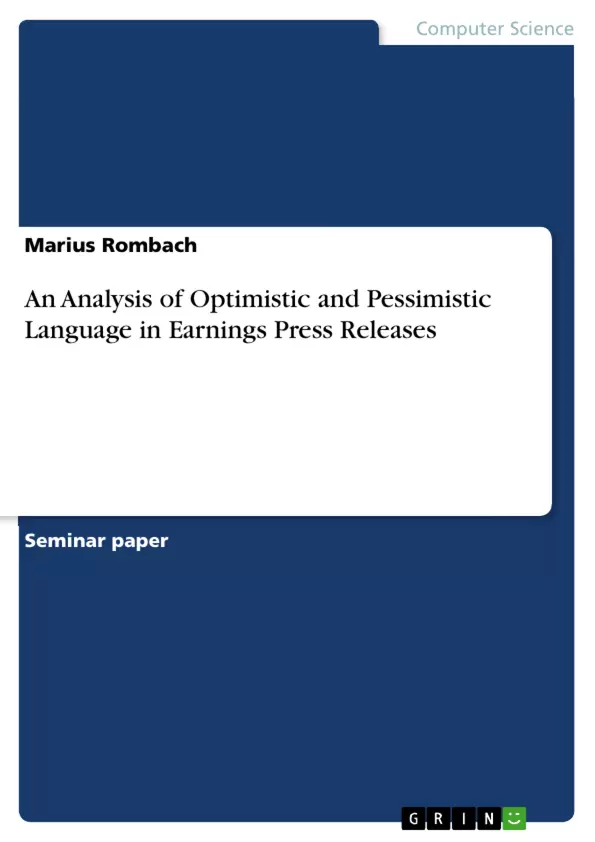Earnings press releases are the major news event of the season for companies and investors, analysts, financial media and the market. As framework of investor relations (IR) they communicate the financial performance in numerical and narrative forms. For example, earnings press releases are obligatory for firms listed on the New York Stock Exchange (NYSE).
There are several rules and guidelines how to prepare them. An accurate earnings press release contains, apart from analyses of operating results, historical data, positive and negative factors affecting key financial indicators, a realistic and truthful forecast of future quarters.
Whereas numerous studies focus on interpretation of numerical forms in earnings press releases, this paper examines the influence of optimistic and pessimistic language in earnings press releases on future firm performance with several studies. It also opposes different approaches to measure the tone.
Based on the study “Beyond the Numbers: An Analysis of Optimistic and Pessimistic Language in Earnings Press Releases” published by Davis, Piger and Sedor the paper presents a textual analysis approach with DICTION 5.0. The authors have been the first scientists so far to examine the role language plays in the credible communication of information to investors.
The dictionary-based content analysis program DICTION 5.0 is able to identify subtle aspects of language. The systematic textual analysis techniques are based on pre-existing search rules. It is able to analyze a larger sample size than possible by human coding or manual reading.
Apart from this, statistical methods – like the naïve Bayesian learning algorithm, reducing a given sentence to a list of words – are introduced and compared with each other.
Given the different approaches to analyze the impact of language in earnings press releases to future earnings a positive correlation between optimistic language and future firm performance can be stated.
Bearing in mind that earnings press releases may use a promotional presentation style of company’s development and opportunistic behavior to delude investors is feasible, current and future applications should be discussed critically.
Table of Contents
- Introduction
- Earnings Press Releases
- Textual Analysis of Optimistic and Pessimistic Language
- Data Sample
- Dictionary approach with DICTION 5.0
- Descriptive Evidence
- Correlation between language usage and future firm performance
- Market response to optimistic and pessimistic language
- A DIFFERENT APPROACH: NAÏVE BAYESIAN LEARNING ALGORITHM
- Similar Studies
- Excursus: A Prospective Business Ratio
- The Business Ratio
- The Data sample
- The Application of NETOPT ratio
- Flaws of NETOPT ratio
- Conclusions
Objectives and Key Themes
This paper analyzes the influence of optimistic and pessimistic language in earnings press releases on a firm’s future performance. It compares different approaches to measure the tone used in these releases, particularly focusing on the narrative form of communication.- The role of language in conveying information to investors
- The connection between language usage and future firm performance
- The impact of optimistic and pessimistic language on market response
- Alternative approaches to textual analysis, such as the naïve Bayesian learning algorithm
- The potential application of linguistic analysis to develop business ratios
Chapter Summaries
- Introduction: This chapter introduces the topic of language in earnings press releases and outlines the paper's objective to analyze the impact of optimistic and pessimistic language on future firm performance. It highlights the importance of narrative communication and previews the different approaches to tone measurement used in the study.
- Earnings Press Releases: This chapter delves into the significance of earnings press releases as a means of communicating firm performance to stakeholders. It discusses the regulatory framework surrounding these releases, including the role of the Securities and Exchange Commission (SEC) and the importance of accurate and truthful forecasting. The chapter also addresses the challenges of analyzing narrative language in earnings press releases, particularly in relation to potential opportunistic behavior.
- Textual Analysis of Optimistic and Pessimistic Language: This chapter explores the approach used by Davis et al. to analyze the connection between language usage and firm performance. It introduces the data sample, the DICTION 5.0 dictionary-based content analysis program, and the methods employed to measure linguistic tone. The chapter also discusses the results of the analysis, including the relationship between linguistic features and future firm performance, as well as the market response to optimistic and pessimistic language.
- A DIFFERENT APPROACH: NAÏVE BAYESIAN LEARNING ALGORITHM: This chapter presents an alternative to textual analysis techniques, focusing on the use of the naïve Bayesian learning algorithm. It compares this approach to the dictionary-based method, highlighting both its advantages and drawbacks.
- Excursus: A Prospective Business Ratio: This chapter explores a potential application of the findings on the relationship between language and firm performance. It proposes the development of a business ratio based on linguistic analysis and discusses its implications for future research.
Keywords
This paper focuses on the interplay between language, financial performance, and market response in the context of earnings press releases. Key themes include textual analysis, optimistic and pessimistic language, dictionary-based approaches, naïve Bayesian learning, firm performance, market returns, and business ratios. The study utilizes a data sample of earnings press releases and investigates the relationship between linguistic features and various accounting and financial variables.- Citation du texte
- cand. rer. pol. Marius Rombach (Auteur), 2011, An Analysis of Optimistic and Pessimistic Language in Earnings Press Releases, Munich, GRIN Verlag, https://www.grin.com/document/180864



